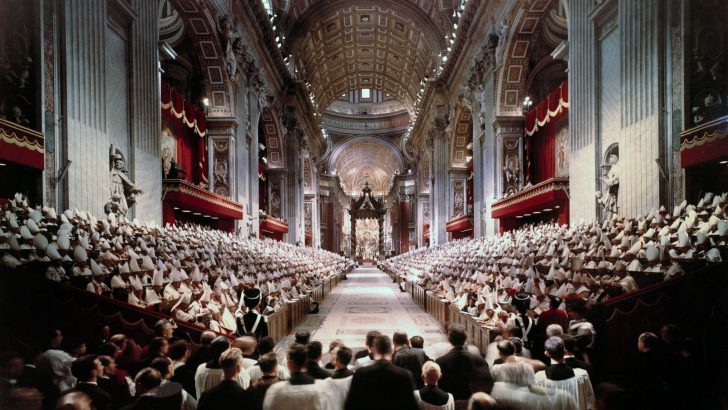Vatican II is only just beginning to bear fruit, Colm Fitzpatrick is told
No other event springs faster to mind when conversing about radical changes in the Church than the occasion of the Second Vatican Council; an event which continues to reverberate in the hearts and minds of Christians today.
With well over 50 years having passed since the 1962-65 council concluded, countless historians and sociologists have offered key insights into its successes and pitfalls, as well as how it can continue to be understood and integrated into the lives of modern-day Catholics.
Adding to this body of scholarship, Dr Gary Carville, Director of Communications in Clogher Diocese, is shining a light on how Ireland responded to the council and why it remains an ongoing challenge and opportunity for the current Irish Church. Graduating with a PhD last month from Dublin City University with his thesis titled, Ireland and Vatican II: Aspects of episcopal engagement with and reception of a Church Council, 1959-1977, the former Fine Gael councillor has provided a comprehensive analysis of Ireland’s reaction to the council, at both an episcopal and lay level.
Significance
Speaking to The Irish Catholic about the significance of the event, Dr Carville says that the Church was trying to “bring its message anew” and to present the Faith in new ways without characterising the world in wholly negative terms.
It was an attempt to “stop looking on the Church as being perfect and the world as being imperfect…but to bring the deposit of Faith, to present it in new ways to the Church and to move out into the modern world with all of its joys, hopes and fears, and to bring the Gospel out into it,” he explains.
In this sense, the council was a call to renewal, or aggiornamento, whereby the Church returned to its sources in order to strengthen and deepen its capacity to engage with modern society. Central to this return was the rediscovery of Scripture in the life of the Church and each other.
“One of the great documents, one of the touchstone documents is Dei Verbum, the document on revelation and Scripture. To me, that is absolutely fundamental to understand and appreciate the place of Scripture in the life of the Church because you can’t understand liturgy or Church teaching unless you have an appreciation of Scripture, both in terms of divine revelation, but also in terms of history,” Dr Carville says.
This return to the sources entailed the removal of many superfluous elements which had developed in the Church over the centuries, both liturgically and theologically.
“Vatican II was about shedding off the bits the Church had been carrying, maybe the forms of monarchy, maybe some elements of liturgy that were maybe not necessary, things that had crept in with practices over the centuries.
“It was a case for decluttering and going back to what was really essential in terms of the Church’s mission to proclaim the Gospel, to live the Gospel, and to be the body of Christ, the people of God in a world that needs to hear the Gospel. The proclaiming of the Scriptures is a key element of that, but also allowing the Church to engage with the modern world,” Dr Carville says.
***
The council undoubtedly had a profound impact on the world as Catholics and Christians tuned in on radio and television globally, but it was inevitably received by different countries in varied and unexpected ways.
Changes were, of course, noticed in Ireland, most notably in the liturgy where parishioners were able to pray in their own language.
The priest was also facing and engaging with the laity, and later people were able to take part in different ministries, like reading and distributing the Eucharist. However, when compared with countries like France, Ireland was very slow, and changes were incremental. Dr Carville also stresses that the reforms were received in a hierarchical manner as Irish people had been so used to a pyramid-like structure of the Church. This monarchical-type institution impeded reception of the council.
“The reception of Vatican II in Ireland was, on the one hand, aided by a model of Church more accustomed to loyally receiving change by directives from above. On the other hand, it was hampered by a lack of theological and intellectual preparedness among clergy and laity. This affected the capacity of Church in Ireland to fully realise the renewal which the council sought to achieve,” Dr Carville continues.
“Ireland’s deep-rooted identification with an institutional-based traditional and devotional form of Catholicism, the divided nature of the communities in Northern Ireland, the homogenous nature of Irish society in the Republic of Ireland, and the beginnings of economic and social change within that society, all impacted upon the capacity of the Church in Ireland to receive fully the council from the beginning.”
Catholicism was a central feature in the life of Ireland, but unlike other Catholic countries such as France or Belgium which were rife with new currents of theological thought that had been developing since the beginning of the 20th Century, Ireland had failed to muster any widespread, rigorous intellectual engagement with new theological or pastoral trends.
Dr Carville suggests that this dearth directly impacted the capacity of the Church in Ireland, through its leaders, to receive the broader vision set out by the council not only through its documents but through the reception of the reform it inspired.
“The bishops themselves weren’t even prepared to deal with it,” he says noting that Cashel’s Archbishop Thomas Morris later said that a lot of the theological ideas discussed during the council were totally foreign to him.
The degree to how insular the Irish Church had become was evident in the ideas for discussion the Irish prelates suggested as part of the ante-preparatory phase of the council, which consisted of issuing condemnations on topics such as evolution and existentialism.
“The peripheral and legalistic disposition of the bishops was further underlined by some bishops who simply wanted the council to clarify or modify liturgical rubrics such as faculties or powers to delegate the administration of confirmation, faculties to erect stations of the cross, guidelines for penances for mortal sins, the length of intervals between the administration of extreme unction, the hours of the breviary and related matters of rubrics,” Dr Carville explains.
“A number of bishops wanted clarity on regulations governing servile work, particularly on holy days of obligation as well as reform of the rules governing fasting and abstinence.”
***
As a result of this gap in innovative theological knowledge and language, the Irish Church resolved to simply implementing diktats from Rome without much dialogue.
This approach meant that the laity were unable to interiorise the reforms, impeding individuals to engage with Christ, Scripture and the Sacraments in the way the council would have and is still seeking us to do. Dr Carville is keen to stress this shouldn’t be seen as a failing but as another challenge because the reception of the council hasn’t ended.
Synodality
“What I’m saying is that the reception of Vatican II is an ongoing process, it will take time. I think the model of ministry that Pope Francis is showing us today in terms of – I know the buzz word ‘synodality’ is used – but really what it is about is walking with people and listening to people’s conversation. That’s very much a product of the council and to me, that’s one of the ways the council is being received and will be further received as time goes on,” Dr Carville says, noting that the process is beginning to bear fruit in Ireland, given current diocesan discussions about parish pastoral areas and lay-led liturgies on weekdays.
He adds that while we can never lose sight of the need for more vocations to the priesthood and religious life, the future of the Church in Ireland will be less clerical, and requires the help of Catholic communities.
“I think that in many ways Vatican II was the work of the Spirit and I think personally speaking, much of what has happened in the Church in Ireland has been the work of the Spirit. It’s about when you’re renewing, when your renewing the body, it involves a process of detoxifying, a letting go, and an opening up wounds and so on. I think that’s what’s been happening in the Church and in that context it’s good. It’s a cleansing, and a much-needed cleansing, and also leading the Church to be much humbler which is hugely necessary and important but also, it’s enabling the baptismal call of people to be realised.”
“It’s also important to enabling trust to build; trust between people and priests, and priests and people. Trust to be built in terms of capacity to lead, capacity to take charge, and where in the past, it has been the case of people helping priests, it will now be the future of priests helping people.”
If historians say it takes a century for an ecumenical council to be received, we’re still in the infancy of Vatican II.
Dr Carville also envisages that the future Church won’t be rooted in territories, but rather different types of smaller communities as we move away from a monarchical and legalistic type of institution.
***
Alongside these innovations, he hopes that in the near future, Ireland holds a national synod, although only when we are spiritually, organisationally, and educationally prepared.
“A national synod, focused on mission, will allow the Church in its fullest reality to engage again in new pastures and allow the whole people of God to be the creative agent and leaven in our communities – from the sources of faith and to the sources of the Church’s lived reality today.
“The potential to engage laity, women, young people, priests, deacons, religious, other faith communities and wider society, is massive.”


 Colm Fitzpatrick
Colm Fitzpatrick The opening session of Vatican II in 1962.
The opening session of Vatican II in 1962. 